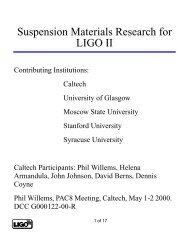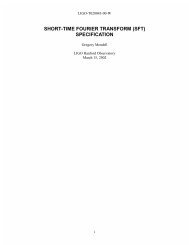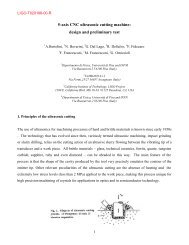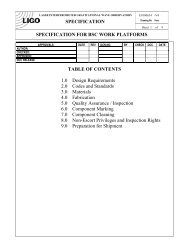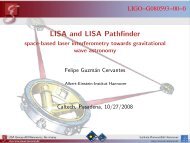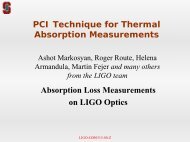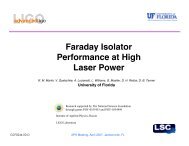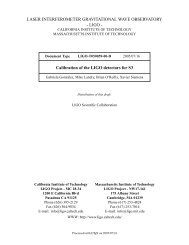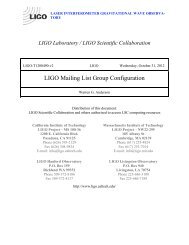High Average Power Fiber Lasers for LIGO
High Average Power Fiber Lasers for LIGO
High Average Power Fiber Lasers for LIGO
Create successful ePaper yourself
Turn your PDF publications into a flip-book with our unique Google optimized e-Paper software.
Stan<strong>for</strong>d Laser Amplifiers <strong>for</strong> <strong>LIGO</strong>Not Pictured: Supriyo Sinha, Karel Urbanek, Yin-Wen Lee,Amber Bullington Larry Randall, Roger Route, Michel Digonnet,Robert L. Byer
Status and Direction• <strong>LIGO</strong> box and amplifier sent to Han<strong>for</strong>d in ‘06• We needed a seed– <strong>Fiber</strong>s at the focus• 10W amplifier designs– Ytterbium-doped silica fibers– Ytterbium-doped phosphate fibers• Continue work on LMA amplifiers– Ytterbium-doped Silica fibers– Erbium-ytterbium co-doped phosphate fibers• Slabs on hold• Ceramic Slabs?
10-W front endGoals• ~10 W of power• Use only standard SMF• All integrated source• Convective cooling (no water!)• <strong>Power</strong> fluctuations of +/- 2%over 40 s• MTTF > 20000 hours• Reliable, easy to use• CHEAP! (40% optical efficiency wrtoutput diode pump power• Low power fluctuations–
Actual LayoutAir-cooled pumps are removedfrom Laser tableInputOutputSilicatebonded flatGain fiber
Pump StrippingFailure SiteWe still hadenoughresidual pumpto melt jacket
Silicate bondingSilicate BondingSilicate bonding can be used to lower optical feedbackFresnel reflection measured to be below -63 dBOptical damage thresholds ~ 500 J/cm 2 at 1 μs
Collimating the signal•Relative position of fiber tip should be fixedw.r.t lens•Commercial holders <strong>for</strong> high powerapplications are rare, and holder usually heatsup, resulting in pointing instability•We propose trial of optical bonding ofaspheric lens to exit surface of optical flat•Must be able to coat the aspheric surface•We have investigated various aspheric lenses
Trouble with Aspheric LensesAll large diameter Aspheric lenses wetried introduced aberrations.After going through afocus, we consistently sawa “donut” mode.Material problem?Design needs to be specific?
Test Results <strong>for</strong> First System•Decent Slope efficiency,(~50%) but weare happy to sacrifice some pump light <strong>for</strong>stability•We did see SBS effects at fiber lengthslonger than 4m, and output signal powers>6W•Observed RIN < 0.1% above 1Hz•Best fiber length ~3.7 metersSignal out121086420-2Single Mode Amplifier Outputy = 0.4966x - 0.72240 5 10 15 20 25Launched PumpA long term test was per<strong>for</strong>med in which thefiber burned in the 31 st hour. Subsequentsplices failed (a good splice requires muchluck) and we needed to order more gainfiber.A Bad Splice (way too common)
Some Results•Reflection dips from the PMC (10-yearold) showed 97% of the light coupled in.•We were able to see stable locking, with82% throughput•Fluctations < 1% above 1Hz200us trace40s traceDark Current
What Now?• The <strong>High</strong>-<strong>Power</strong> fiber laser industrycontinues to move very fast– Very soon the following will be known• 20-W 100-µm-fiber-coupled wavelength-stabilizedpumps will be available <strong>for</strong> about $2k– Temperature feedback control is unnecessary --- diodescan be fan cooled– 1 diode per 10-W system (the pump diode industry isalso making progress)• Suitable high-power pump / signal combiners willbe available <strong>for</strong> about $300
Build Your Own!• Cost of materials– Pump diode $2000– Signal / Pump combiner 300– Gain fiber 200– Taps, monitor PD’s, polarizer 1000– Electronics, diode driver 1000– Assembly ?All in all, a 10W amplifier <strong>for</strong> less than $5k
Future System Proposal30W integrated system uses only 3pump diodes and simplified controls
<strong>High</strong> <strong>Power</strong>, Single FrequencyYtterbium <strong>Fiber</strong> Amplifier(Not quite ready <strong>for</strong> the commercial market)
Optical Layout (new)136-W single-frequency, polarizedfiber amplifier operating at 1064 nmCharacterized noise propertiesof LMA fiber amplifierDrilled hole hereto monitor pump
<strong>High</strong> <strong>Power</strong> <strong>Fiber</strong> Amplifier ResultsReflection versus Voltage0.15Voltage (a.u.)0.10.050-0.05TEM 00ReflectionPZT voltageFSRZero0 0.02 0.04 0.06 0.08 0.1M 2 < 1.05-0.1(b)-0.15Time (s)Analysis of mode cleaner reflection spectrum indicates that less than 1.5%of the output power is contained in the higher order modes at 10 W level136 W of output power achieved with a PER of 15 dB but output powerfluctuates by +/-10% on a ~30-second timescale due to periodic drift inthe laser diode output spectrum.
LMA <strong>Fiber</strong> Amplifier <strong>High</strong>lights• Gain fiber was kept very short to minimize spontaneousBrillouin scattering excess noise (side effect was that theoutput power is more sensitive to pump wavelength)• Long period output power fluctuations could beeliminated with wavelength-stabilized pumps or pumpswith better cooling geometry that have minimalwavelength drift• Amplifier has been used on-and-off <strong>for</strong> months withoutdegradation or failure• Used to set world record <strong>for</strong> diffraction-limited singlepassfrequency doubling (19W of 532nm light)** PPSLT provided by David Hum, Stan<strong>for</strong>d University
150W System LayoutAll key components have now been developed (in houseand/or commercially) over the last few years
Phosphate fiber sources
Meet Yin-Wen LeeBuilt 10W and 25Wsingle-mode Yb-dopedPhosphate fiber amplifierand laserWorking toward 100Wclass Yb-dopedphosphate fiber lasersourcesleeyw@stan<strong>for</strong>d.edu
Double-Clad Phosphate <strong>Fiber</strong><strong>Fiber</strong> fabrication:• Rod-in tube technique• Eliminated the alkali ions12 wt% of Yb 2 O 33-dB/m passive loss• SBS gain co-efficient looks to be 2x lower than silica (2.34 e -11 m/W)• Photodarkening threshold appears to be orders of magnitude above silica
25-W Single-mode Yb 3+ -doped phosphate fiber lasers22Laser output power (W)2018161412108642Slope efficiency:25.8 % (launched pump power)34.4 % (absorbed pump power)experimental datasimulation curve00 10 20 30 40 50 60 70 80940-nm launched pump power (W)Slope efficiency:52.7% (launched pump power)59.4 % (absorbed pump power)• The slope efficiency can be improved by pumping at 975 nm or decreasing thepassive propagation loss• The background propagating loss is mainly due to impurities of glass pre<strong>for</strong>ms
10-W Single-mode Yb 3+ -doped phosphate fiber MOPA• The pump absorption can be improved by breaking the symmetry ofthe inner cladding, such as using a PM fiber• Our collaborators at NP photonics are making PM Yb 3+ doped doublecladsingle-mode fiber
Conclusions and Future Work• Built and began testing a successful 10-W fiber amplifier using atruly single-mode ytterbium-doped silica fiber• Continued to improve upon the high-power LMA silica fiber amplifier,increasing stability and beam quality• After 10W amplifier is rebuilt, we will be able to do a fullcharacterization and long lifetime test.• We will begin construction on a 2 nd -generation amplifier, consistingof only 1 fiber-coupled wavelength-stabilized diode source, fewerelectronics, and a smaller footprint• A 100-W class phosphate fiber amplifier will be built and tested thiscoming year• We will find a suitable replacement <strong>for</strong> Supriyo– Note: <strong>Average</strong> winter temperature <strong>for</strong> Palo Alto: 11 deg. C• <strong>Average</strong> Summer temperature: 21 deg. C



